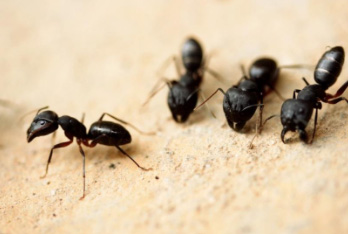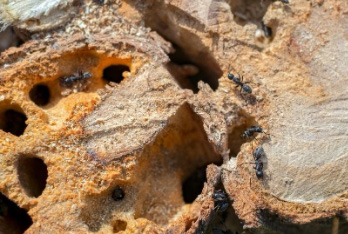CARPENTER ANT CONTROL

One of the most aggressive nature’s wood destroyers are carpenter ants, they may cause lots of damage to wooden structures. Besides, they are a common invader of homes in the northeastern U.S. These facts make them a big concern for homeowners.
Not sure if you have a carpenter ant problem? Or maybe you want to learn more about how carpenter ant control works. Check out the following information to clarify some questions you may have.
WHAT ARE CARPENTER ANTS?
Carpenter ants are the largest ants in the continent; they can measure up to five-eighths of an inch long. Apart from their size, they resemble other ants, with the adult body clearly divided into head, thorax and abdomen. They are known as carpenter ants because of the smooth clean sculptured appearance of their nesting galleries. Although they excavate wood they are incapable of digesting cellulose like termites; they bore into wood to stablish or expand their nest only, since they feed on a wide range of organic matter. Carpenter ants play an important role in the environment by acting as major decomposers of dead or fallen trees within the forest.
Like other ants, they are social insects, sharing duties with their colony. Their nests might be indoors or outdoors. There are four life stages: egg, larva, pupa and adult. The adults are divided into three castes:
- Queen, responsible for laying eggs.
- Adult minor workers, take on the responsibilities of the colony as foraging for food, tending to the eggs, larvae and pupae, and excavating galleries to broaden and propagate their nest.
- Adult major workers, soldiers who guard the nest.
HOW TO IDENTIFY CARPENTER ANTS
Carpenter ants are larger than many other varieties of ants and are either black or darker brown. While their appearance is a good way to identify and distinguish them from other types of ants or termites, the following are some other characteristics that can help you identify them:
- Even though they follow particular pathways, they may not form wide and continuous moving masses of thousands of bodies like army ants.
- Their grouping behavior is more often around food or water sources, unlike other ants that form straight and single-file lines.
- Carpenter ants remove the wood when forming their nests, the discarded wood looks like shredded sawdust; while termites’ discarded wood looks more like mud material.
- The damage caused by carpenter ants is neater than termite damage because they take all debris out of the nesting area leaving hollow empty tubes in the wood.
WHAT CAUSES CARPENTER ANT INFESTATIONS?
Carpenter ants usually nest in trees, shrubs and other rotting or damp wood; but they will get into properties if needed in order to expand it. They discover new places to expand their nest, when looking for food by traveling out their colony, which may be located in a nearby tree or shrub. Carpenter ants can also bore nests within stored wood you may have at your property and then migrate throughout other areas of your home.
These ants prefer to nest in moist wood and previously damaged structures by other insects; even though, they will still create paths through healthy wood if necessary. Cracks around windows and doors might be a good way to enter into wooden structures for them; besides, carpenter ants are known to use utility lines to get behind the walls and set up a colony.
HOW TO IDENTIFY A CARPENTER ANT INFESTATION?
Most of the time carpenter ant infestations go unnoticed until it’s too late, becoming a cost-ridden situation because of the wood damage, which is not easily corrected. Therefore, it’s vital to recognize the signs of an infestation. Here is a list of the most common and noticeable signs:
- Piles of wood shavings; usually found beneath wooden items, sign of a severe infestation.
- Large winged ants emerging from ceiling, walls and other hidden crevices, certain sign of an infestation.
- Faint rustling noises inside woodwork or walls, audible sound made by carpenter ants when they are moving around and building their nest.
- Hollow wood, stud that is infested with termites will sound hollow compared to a solid stud.
- Presence of workers inside a building or home, the most evident sign of infestation; however, this is not a conclusive evidence of an established colony within a structure since they forage within grate distances for food.
WHAT MAY CARPENTER ANTS IN OR AROUND YOUR PROPERTY CAUSE?
As mentioned before, carpenter ants are one of the most aggressive wood destroying insects, making them a danger for homeowners. Even though carpenter ants usually nest in trees, they may get into your property when expanding their nest. The larger the colony, the more wood these ants will need to excavate in order to accommodate themselves. They often prefer moist wood since they need water to survive. Their pathways look like smooth, round tunnels and can be found in any areas they are nesting at.
Carpenter ants can cause costly damage to different wood structures in your property such as walls, floors, roof, cabinets, etc. Since carpenter ants spread from one place to another, once they are in an area they may bore away wood structures until they cannot support weight, compromising some wood elements of your home. Although they do not usually cause extensive damage like termites would, their presence in your home can lead to greater issues if left untreated for a long period of time.

TIPS FOR PROPERTY OWNERS
As mentioned before, carpenter ants may cause lots of wood damage; therefore, we have listed some tips for homeowners in order to prevent your home or business from a carpenter ant infestation:
- Correct moisture problems, fixe water leaks from roofs and plumbing.
- Store firewood away from the house, elevated off the ground if possible; and trim back bushes and trees from the edge of the house.
- Seal cracks and openings around the foundation with caulk, especially where utility pipes and wires enter from the outside.
- Install proper screening in windows and door sweeps on entry doors.
- Cut back tree limbs or branches that could serve as bridge for carpenter ants to your structure.
- Regularly wipe down counters and vacuum floors to remove crumbs.
- Use airtight containers to store food in the pantry.
WHAT WILL WE DO?
Our carpenter ant control process typically consists of the following stages:
- Inspect your property to determine if, where and how carpenter ants are getting in.
- Offer pest control programs to get the carpenter ant problem under control.
- Treat the existing carpenter ant infestation and prevent future infestations.
Want a Free Estimate?
Need to Schedule Service?
Have a Questions?
WHY CHOOSE E&G PEST SOLUTIONS?
- All of our services are guaranteed. We deliver what we promise or your money back,
- We were chosen business leader of the year in Middlesex County, member of Home Advisor and Angie’sList.
- We offer unique and effective pest solutions
- We are environmentally conscious
- We provide termite inspection reports for real estate transactions
What our clients are saying
Our Partners and Awards
Service area
New Jersey:
Ocean County
Essex County
Passaic County
Morris County
Hudson County
Bergen County









